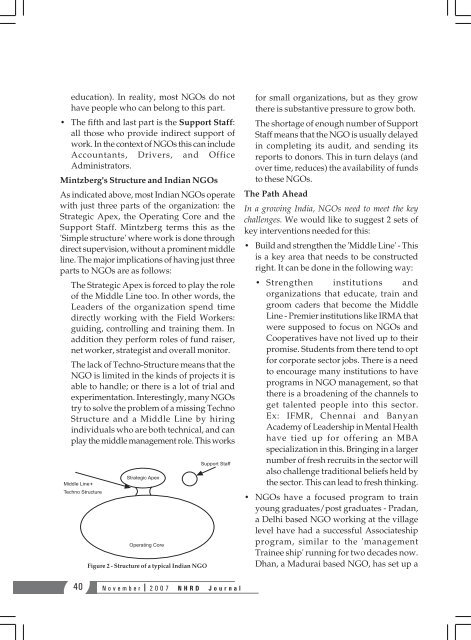NHRD Journal - National HRD Network
NHRD Journal - National HRD Network
NHRD Journal - National HRD Network
Create successful ePaper yourself
Turn your PDF publications into a flip-book with our unique Google optimized e-Paper software.
education). In reality, most NGOs do not<br />
have people who can belong to this part.<br />
• The fifth and last part is the Support Staff:<br />
all those who provide indirect support of<br />
work. In the context of NGOs this can include<br />
Accountants, Drivers, and Office<br />
Administrators.<br />
Mintzberg's Structure and Indian NGOs<br />
As indicated above, most Indian NGOs operate<br />
with just three parts of the organization: the<br />
Strategic Apex, the Operating Core and the<br />
Support Staff. Mintzberg terms this as the<br />
'Simple structure' where work is done through<br />
direct supervision, without a prominent middle<br />
line. The major implications of having just three<br />
parts to NGOs are as follows:<br />
The Strategic Apex is forced to play the role<br />
of the Middle Line too. In other words, the<br />
Leaders of the organization spend time<br />
directly working with the Field Workers:<br />
guiding, controlling and training them. In<br />
addition they perform roles of fund raiser,<br />
net worker, strategist and overall monitor.<br />
The lack of Techno-Structure means that the<br />
NGO is limited in the kinds of projects it is<br />
able to handle; or there is a lot of trial and<br />
experimentation. Interestingly, many NGOs<br />
try to solve the problem of a missing Techno<br />
Structure and a Middle Line by hiring<br />
individuals who are both technical, and can<br />
play the middle management role. This works<br />
+<br />
Figure 2 - Structure of a typical Indian NGO<br />
for small organizations, but as they grow<br />
there is substantive pressure to grow both.<br />
The shortage of enough number of Support<br />
Staff means that the NGO is usually delayed<br />
in completing its audit, and sending its<br />
reports to donors. This in turn delays (and<br />
over time, reduces) the availability of funds<br />
to these NGOs.<br />
The Path Ahead<br />
In a growing India, NGOs need to meet the key<br />
challenges. We would like to suggest 2 sets of<br />
key interventions needed for this:<br />
• Build and strengthen the 'Middle Line' - This<br />
is a key area that needs to be constructed<br />
right. It can be done in the following way:<br />
• Strengthen institutions and<br />
organizations that educate, train and<br />
groom caders that become the Middle<br />
Line - Premier institutions like IRMA that<br />
were supposed to focus on NGOs and<br />
Cooperatives have not lived up to their<br />
promise. Students from there tend to opt<br />
for corporate sector jobs. There is a need<br />
to encourage many institutions to have<br />
programs in NGO management, so that<br />
there is a broadening of the channels to<br />
get talented people into this sector.<br />
Ex: IFMR, Chennai and Banyan<br />
Academy of Leadership in Mental Health<br />
have tied up for offering an MBA<br />
specialization in this. Bringing in a larger<br />
number of fresh recruits in the sector will<br />
also challenge traditional beliefs held by<br />
the sector. This can lead to fresh thinking.<br />
• NGOs have a focused program to train<br />
young graduates/post graduates - Pradan,<br />
a Delhi based NGO working at the village<br />
level have had a successful Associateship<br />
program, similar to the 'management<br />
Trainee ship' running for two decades now.<br />
Dhan, a Madurai based NGO, has set up a<br />
40<br />
November 2007 <strong>N<strong>HRD</strong></strong> <strong>Journal</strong>
















